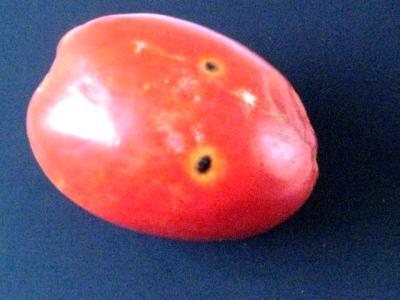

Bacterial canker (Clavibacter michiganensis subsp. michiganensis)
The first symptoms are yellowing, curling and wilting of the leaflets, often on one side of the leaf. The affected leaflets turn brown and dry but remain attached to the plant. The whole plant may also show a one-sided disease development. Long brown strips may appear on stems and shoots. These strips dry and crack open to form cankers from which the disease gets its name. When an affected stem is cut lengthwise, there is a creamy white, yellow or reddish-brown line inside the woody tissue. The pith is easily separated from the wood along this line.
The vascular bundles within the pith are destroyed and cavities are formed in the pith. Young affected fruits are small, deformed and seeds are aborted. Also spots may develop on older fruits. These spots are circular, up to three mm wide, with slightly raised brown centre surrounded by a pronounced white halo resembling a 'bird's eye". The halo is flat. The bacterium is seed-borne and can survive up to three years in soil in crop debris. Spread within a crop is by rain splash, sprinklers and pruning knives.
- Plant tolerant or resistant varieties, if available.
- Use certified disease-free seeds.
- Rotate seedbeds and tomato fields with non-solanaceous crops.
- Eradicate solanaceous weeds.
- Avoid sprinkler irrigation where the disease is endemic.
- Avoid working in tomato fields when it is wet.
- Disinfect pruning knives with commercial detergents between plants .
